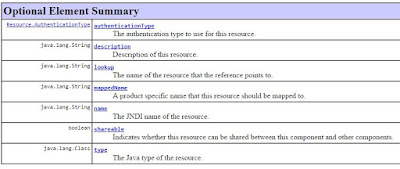12.1. Understand the role of the container in security
-Authentication
-Authorization
-Confidentiality
-Data integrity
The security should be declared in the deployment descriptor (it is possible to use annotations too).
<security-constraint>
<web-resource-collection>
<web-resource-name>EditPage</web-resource-name>
<url-pattern>/DemoServlet/Edit/*</url-pattern>
<http-method>POST</http-method>
</web-resource-collection>
<auth-constraint>
<role-name>Admin</role-name>
<role-name>User1</role-name>
</auth-constraint>
</security-constraint>
When <role-name>*</role-name> or no auth constraint defined all roles have access to the resources described.
When <auth-constraint/> no roles have access.
12.2. Describe and implement four authentication models
- BASIC Data is encoded in base64(not encrypted).
- DIGEST Data is encrypted (not SSL) but no all JEE containers support it.
- CLIENT-CERT Using Public key certificates. Clients need to have a certificate to use it.
- FORM Creating a custom login form. Data are sent in http request with no encryption
The authentication type is declared in DD
<login-config>
<auth-method>FORM</auth-method>
In the Form authentication type the loginPage should be defined (using these three fields: j_security_check, j_username, j_password
<form method="POST" action="j_security_check">
<input type="text" name="j_username">
<input type="password" name="j_password">
<input type="submit" value="Enter">
</form>
12.3. Force the use of encryption between a web application and the client browser.
Annotation ServletSecurity.TransportGuarantee
-NONE
-CONFIDENTIAL: All user data must be encrypted by the transport (typically using SSL/TLS).
@ServletSecurity(@HttpConstraint(transportGuarantee = TransportGuarantee.CONFIDENTIAL))
12.4. Understand the role of JAAS in pluggable/extensible authentication for web applications
JAAS can be used for two purposes:
- for authentication of users,
- for authorization of users to ensure they have the access control rights required to do the actions performed.
OCEJWCD (SCWCD) - 1Z0-899 - Web Component Developer Certification




